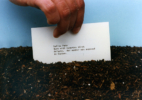Gallery Luisotti is pleased to announce its upcoming group exhibition, When we were young. The exhibition features some of the earliest works ever produced by gallery artists John Divola, Christina Fernandez, Ron Jude, Mark Ruwedel and Catherine Wagner. A working through of concerns of the photographic medium in roughly the years 1970-1985/2010 is visible in the artists’ varied approaches. Individually, the works in the exhibition interrogate the notion of photograph as document, about the gaps inherent to narrative, and images existing not for a market, but for dialogue and contemplation as strategies to move individual practices and the photographic medium forward. The exhibition has the benefit of retrospectively looking at past moments of artistic success and placing them on a larger trajectory of artistic mastery. As Harvard professor Sarah Lewis writes in her recent book, The Rise: Creativity, the Gift of Failure, and the Search for Mastery:
Mastery requires endurance. Mastery, a word we don’t use often, is not the equivalent of what we might consider its cognate—perfectionism—an inhuman aim motivated by a concern with how others view us. Mastery is also not the same as success—an event-based victory based on a peak point, a punctuated moment in time. Mastery is not merely a commitment to a goal, but to a curved-line, constant pursuit.
The exhibited photographs were originally intended for varied and at times ambiguous contexts. Some, such as Divola’s application (1970-71) to the MFA program at UCLA, would have only been seen by himself, those around him with whom he chose to share it, and the committee of professors supervising admissions. Similarly, Fernandez’s gelatin silver prints made from spliced-together negatives showing herself and children who lived in her apartment building were made as an undergraduate at UCLA, but already manifest her concerns with identity and self-representation. Only a single heated group critique bore witness to her small color photographs of cards identifying farm worker and sharecropper pesticide victims. Emmett, a series of snapshots by a teenaged Ron Jude, is an example of appropriation that uses photographic material from the artist’s earlier life, in this case a non-art context. The naïveté present causes tension as soon as the works are made larger and polished 30 years after the fact.
The works on view by Ruwedel and Wagner speak to nascent mastery—literally their university-sanctioned Master of Fine Arts degrees—by foreshadowing ideas that remain present in their practices today. Ruwedel’s Evans Street is filled with the kind of art historical reference points and personal affect that mark his later work. Wagner’s California Landscapes commences an indexing of the land’s idiosyncrasies: ripped window screens, tattered and dirty draped cloth, buildings being built, buildings falling apart. Wagner continues to seek out these quirks of the built environment and social systems.
Taking the broader view from five particular moments in these artists’ lives, one sees not so much a concern with success as defined above, but in taking the road less traveled towards mastery.































